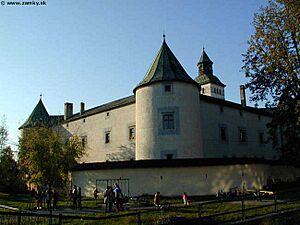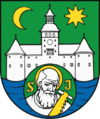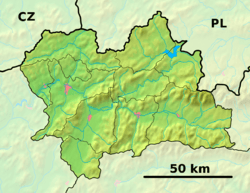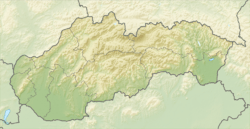Bytča facts for kids
Quick facts for kids
Bytča
|
||
|---|---|---|
|
town
|
||

Bytča Castle
|
||
|
||
| Country | ||
| Region | Žilina | |
| District | Bytča | |
| First mentioned | 1234 | |
| Area | ||
| • Total | 43.04 km2 (16.62 sq mi) | |
| (2022) | ||
| Elevation | 337 m (1,106 ft) | |
| Population
(2022)
|
||
| • Total | 11,448 | |
| • Density | 265.99/km2 (688.90/sq mi) | |
| Time zone | UTC+1 (CET) | |
| • Summer (DST) | UTC+2 (CEST) | |
| Postal code |
014 01
|
|
| Area code(s) | +421 41 | |
| Car plate | BY | |
| Website | www.bytca.sk | |
Bytča is a town in northwestern Slovakia. It is located by the Váh River. The cities of Žilina and Považská Bystrica are nearby. Bytča is part of the beautiful Upper Váh region, which is popular for tourism.
Contents
What's in a Name?
The name Bytča comes from an old Slavic personal name. This name was Bytek or Bytko.
A Look Back in Time
Bytča became a town in 1946. This happened when several smaller settlements joined together. These included Malá Bytča, Veľká Bytča, and Hliník nad Váhom.
The first time Veľká Bytča was mentioned in writing was in 1234. It was called terra Bycha back then. The town officially received its town rights in 1378. Bytča was once an important center for feudal lords. Later, it became known for its many skilled craftsmen.
Cool Places to See
Bytča has a famous castle called the Thurzó Castle. It was first built as a water castle in the 13th century. Later, in the 16th century, it was rebuilt in the Renaissance style.
The town also has the Wedding Palace, built in 1601. György Thurzó had it built for his daughters' weddings. It is the only building of its kind in Slovakia. You can also see old Renaissance, Baroque, and Classical houses. The Wedding Palace also has a museum.
Who Lives Here?
In 2001, Bytča had about 11,150 people living there. Most of the people, about 98%, were Slovaks. About 90% of the people were Roman Catholics.
What People Do for Work
Today, Bytča is home to several industries. There are companies that make machines, like Kinex. Other businesses work with textiles and wood processing. They even used to make sports equipment here. There was also a food industry, including a brewery, but it closed in the 2010s.
Parts of Bytča
Bytča is made up of several areas that used to be separate villages.
- Beňov (joined with Malá Bytča around 1899)
- Hliník nad Váhom (joined in 1946)
- Hrabové (joined in 1971)
- Malá Bytča (joined in 1946)
- Mikšová (joined with Malá Bytča in 1907)
- Pšurnovice (joined in 1971)
- Veľká Bytča (joined in 1946)
Town Friends Around the World
Bytča has "twin towns" or "sister cities." These are towns in other countries that have a special friendship with Bytča.
Famous People from Bytča
- Adolf Neubauer, a Jewish scholar.
- Jozef Tiso (1887–1947), a Slovak priest and politician who led the First Slovak Republic from 1939 to 1945.
See also
 In Spanish: Bytča para niños
In Spanish: Bytča para niños




